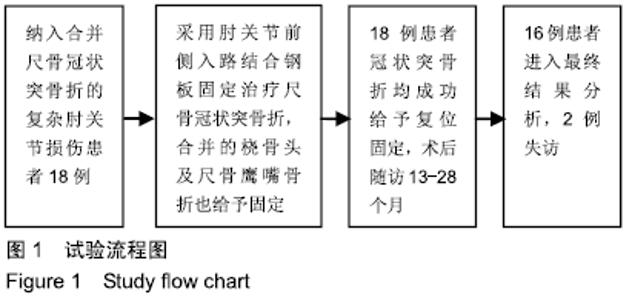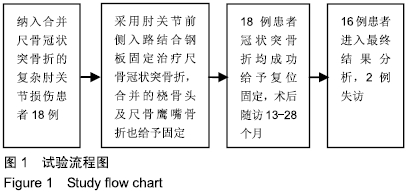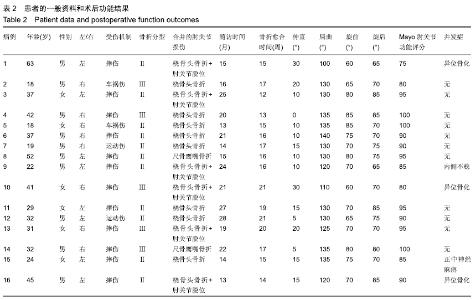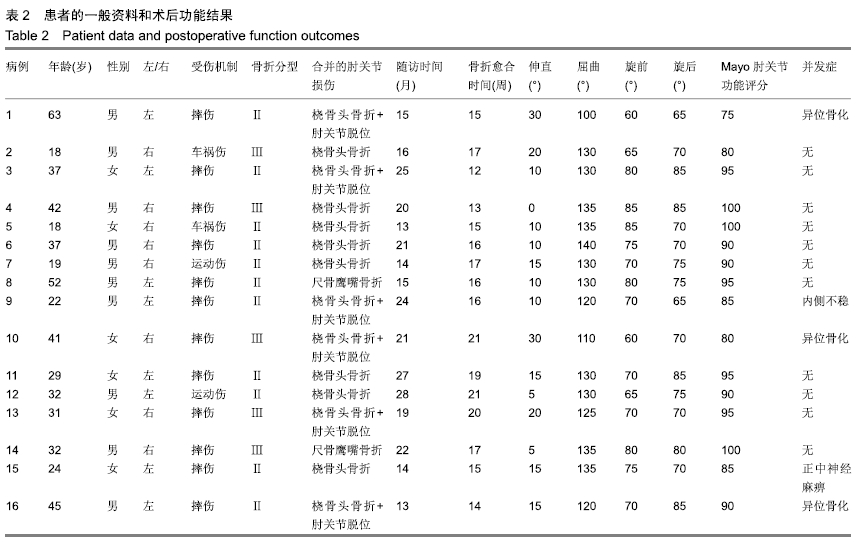[1] AMIS AA, MILLER JH. The mechanisms of elbow fractures: an investigation using impact tests in vitro.Injury.1995; 26(3): 163-168.
[2] HOTCHKISS RN. Fractures and dislocations of the elbow// Rockwood CA, Green DP, Bucholz RW, Heckman JD, editors. 4th ed., Rockwood and Green’s fractures in adults, vol. 1, 4th ed. Philadelphia: Lippincott-Raven; 1996:929-1024.
[3] YANG X, CHANG W, CHEN W, et al. A novel anterior approach for the fixation of ulnar coronoid process fractures. Orthop Traumatol Surg Res. 2017;103(6):899-904.
[4] 朱文峰,孙焕建,蔡浩,等.内侧单切口双窗口入路治疗尺骨冠状突骨折[J].中华手外科杂志,2018,34(3):177-180.
[5] 王华松,吴刚,丁然,等.肘前入路微型钢板内固定治疗尺骨冠状突骨折[J].中华创伤杂志,2018,34(4):345-350.
[6] HAN SH, YOON HK, RHEE SY, et al. Anterior approach for fixation of isolated type III coronoid process fracture. Eur J Orthop Surg Traumatol. 2013;23(4):395-405.
[7] 韦旭明,芮永军,宋骁军,等.前侧和外侧联合入路治疗肘关节损伤三联征的疗效评价[J].中华创伤杂志, 2016, 32(10):921-925.
[8] 程宇,张志刚,徐耀增,等.前后联合入路治疗经鹰嘴肘关节骨折脱位[J].中华创伤骨科杂志,2016,18(7):630-633.
[9] REGAN W, MORREY BF. Classification and treatment of coronoid process fractures. Orthopedics. 1992;15(7):845-848.
[10] MASON ML. Some observations on fractures ofthe head of the radius with a review of one hundred cases. Br J Surg. 1954;42(172):123-132.
[11] MORREY BF. Current concepts in the treatment of fractures of the radial head, the olecranon, and the coronoid. Instr Course Lect. 1995;44:175-185.
[12] PUGH DM, WILD LM, Schemitsch EH, et al. Standard surgical protocol to treat elbow dislocations with radial head and coronoid fractures. J Bone Joint Surg Am. 2004;86-A(6): 1122-1130.
[13] ZHANG C, ZHONG B, LUO CF. Treatment strategy of terrible triad of the elbow: experience in Shanghai 6th People's Hospital. Injury. 2014;45(6):942-948.
[14] MORREY BF, AN KN. Functional evalution of the elbow. In: Morrey BF, Sanchez-Sotelo J (eds) The elbow and its disorders. 4th edn. Saunders Elsevier, Philadelphie, 2009: 80-91.
[15] FENG D, ZHANG X, JIANG Y, et al. Plate fixation through an anterior approach for coronoid process fractures: A retrospective case series and a literature review. Medicine. 2018;97(36):e12041.
[16] MORREY BF, ASKEW LJ, AN KN, et al. A biomechanical study of normal functional elbow motion. J Bone Joint Surg Am. 1981;63:872-877.
[17] BROBERG MA, MORREY BF. Results of delayed excision of the radial head after fracture. J Bone Joint Surg Am.1986; 68(5):669-674.
[18] HASTINGS H, CRAHAM TJ.The classification and treatment of heterotopic ossification about the elbow and forearm. Hand Clin.1994;10(3):417-437.
[19] 王鹏飞,庄岩,魏巍,等.袢钢板治疗Regan-Morrey I型冠状突骨折[J].中华创伤骨科杂志.2015,17(4):277-281.
[20] SHIMURA H, NIMURA A, NASU H, et al. Joint capsule attachment to the coronoid process of the ulna: an anatomic study with implications regarding the type 1 fractures of the coronoid process of the O'Driscoll classification. J Shoulder Elbow Surg. 2016;25(9):1517-1522.
[21] 贺韬,张云辉,李亘,等.肘关节前内侧入路治疗冠状突骨折的解剖学研究及临床应用[J].中华创伤骨科杂志,2017,19(7):559-565.
[22] CLOSKEY RF, GOODE JR, KIRSCHENBAUM D, et al. The role of the coronoid process in elbow stability: a biomechanical analysis of axial loading. J Bone Joint Surg Am. 2000;82: 1749-1753.
[23] YOON RS, TYAGI V, CANTLON MB, et al. Complex coronoid and proximal ulna fractures are we getting better at fixing these? Injury. 2016;47(10):2053-2059.
[24] 包志刚,黎润光.尺骨冠状突重建的研究进展[J].中华创伤骨科杂志, 2018, 20(11):980-985.
[25] 陈红卫,李军,王子阳,等.前内侧入路治疗尺骨冠状突骨折[J].中华手外科杂志,2015,31(4):276-279.
[26] CHEN HW, TENG XF. A comparative study on the validity and reliability of anterior, medial, and posterior approaches for internal fixation in the repair of fractures of the coronoid process of the ulna. Eur J Med Res. 2018;23(1):40.
[27] 刘观燚,潘志军,马维虎,等.伴有前内侧冠状突骨折的肘关节“三联征”的手术治疗策略[J].中华创伤骨科杂志, 2017,19(7):578-583.
[28] MOON JG, ZOBITZ ME, AN KN, et al. Optimal screw orientation for fixation of coronoid fractures. J Orthop Trauma. 2009; 23(4):277-280.
[29] MORELLATO J, LOUATI H, DESLOGES W, et al. Fixation of Anteromedial Coronoid Facet Fractures:A Biomechanical Evaluation of Plated VersusScrew Constructs. J Orthop Trauma. 2018;32(11):e451-e456.
[30] CHEN HW, HE HH, GAO BL. Efficacy of internal fixation with mini plate and internal fixation with hollow screw for Regan-Morrey type II and III ulna coronoid fractures. BMC Musculoskelet Disord. 2018;19(1):194.
[31] MORREY BF, TANAKA S, AN KN. Valgus stability of the elbow. A definition of primary and secondary constraints. Clin Orthop.1991;265:187-195.
[32] HEIM U. Combined fractures of the radius and the ulna at the elbow level in the adult. Analysis of 120 cases after more than 1 year. Rev Chir Orthop Reparatrice Appar Mot.1998;84:142-153.
[33] RING D, JUPITER JB, ZILBERFARB J. Posterior dislocation of the elbow with fractures of the radial head and coronoid. J Bone Joint Surg Am. 2002;84:547-551.
[34] MALLARD F, HUBERT L, STEIGER V, et al. An original internal fixation technique by tension band wiring with steel wire in fractures of thecoronoid process. Orthop Traumatol Surg Res. 2015;101(4 Suppl):S211-215.
|







